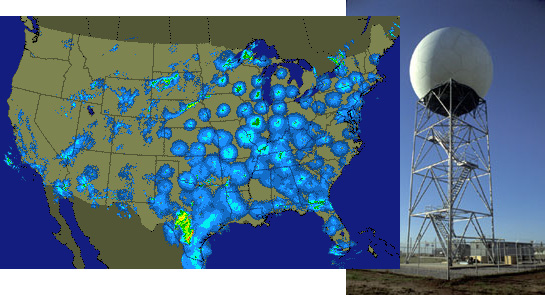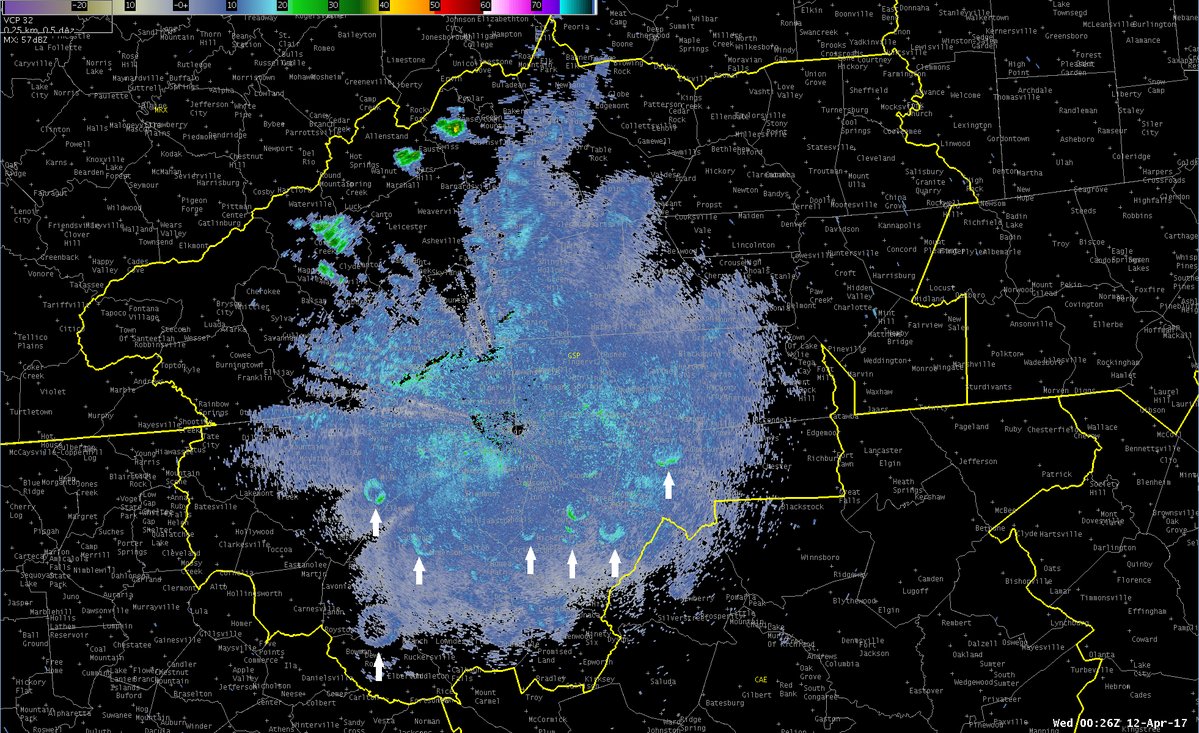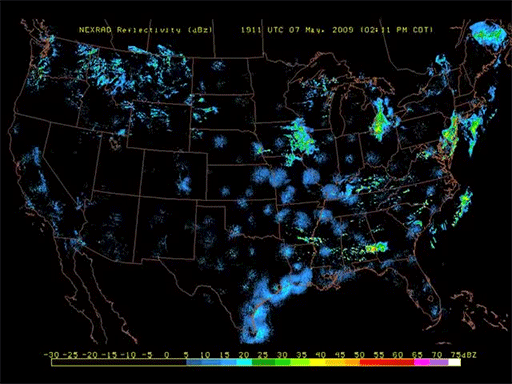You are using an out of date browser. It may not display this or other websites correctly.
You should upgrade or use an alternative browser.
You should upgrade or use an alternative browser.
Looks like it's an unprocessed dataset showing artifacts near each stations from bugs, birds, and bats.
http://www.animalmigration.org/aeroecology/index.htm


http://www.animalmigration.org/aeroecology/index.htm
During some periods, most of the reflectivity detected by NEXRAD radars is biological - primarily birds, bats and bugs. The images above display composite reflectivity obtained from the NMQ web portal May 17, 2010. The left panel shows a reflectivity map before applying quality control to remove non-meteorological effects. The date is near the peak of nocturnal spring migration of songbirds in the northern part of the U.S.; insects and probably bats also contribute to the radar return. The lower panel shows the same data after quality control. The underlaid grey shading denotes terrain elevation with lighter colors repesenting higher elevations.
deirdre
Senior Member.
image search pulls up alot of similar maps and they all say "birds"What are these blue splotches?
Spectrar Ghost
Senior Member.
Bird migrations is correct
http://www.smithsonianmag.com/smart-news/how-doppler-radar-can-track-bird-migrations-180952834/
http://www.smithsonianmag.com/smart-news/how-doppler-radar-can-track-bird-migrations-180952834/
In the video above, posted a couple years back by Christopher Wood, blue stippled circles bloom and spread over the continental U.S., all coinciding with the half-hour after local sunsets. Those circles are birds—this is a pattern typical of large groups of birds taking off to resume migration.
Last edited by a moderator:
Chew
Senior Member.
Before radar they used the moon to estimate the populations of birds that migrated at night:
http://www.wbu.com/chipperwoods/photos/moon.htm
http://www.wbu.com/chipperwoods/photos/moon.htm
Many species of birds choose to migrate at night. Unfortunately for most bird watchers, millions of birds pass undetected through the night sky in the spring and fall as they make their journey between their breeding and wintering grounds.
In 1952, an organized, continent-wide network of 1,391 birders and astronomers performed counts of nocturnal migrant birds crossing the full moon (Lowery and Newman, 1966). From the 1st to the 5th of October that year, observers across North America manned 265 observation points in three Canadian provinces and every state except Alaska, Hawaii, Maine, Nevada and Utah. A total of 35,407 birds silhouetted against the moon were counted. Data were then compared with weather patterns across North America to discover relationships and patterns that affect the movement of birds.
Last edited by a moderator:
https://www.fort.usgs.gov/radar

https://www.sciencebase.gov/catalog/item/56c6431ce4b0946c6523193c

Some keywords for searches: Aerofauna, Bioscatter, biological scatterers.
LEFT: Radar captures this snapshot of bird migration across the eastern and central United States on April 28, 2004, at 23:02 CDT. Precipitation appears over southern Texas and across parts of the West. Individual radars detect birds out to a certain range, shown as circular patterns of echoes. The overall pattern indicates that birds are migrating as a relatively continuous layer throughout the east-central United States.
RIGHT: NEXRAD (NEXt generation RADar) is also known as Weather Surveillance Radar, 1988 Doppler (WSR-88D). Pictured is the tower that houses the antennae inside the radome (white sphere).
https://www.sciencebase.gov/catalog/item/56c6431ce4b0946c6523193c
CeruleanBlu
Senior Member.
Another example of this tonight:

National Weather Service Greenville-Spartanburg, SC reports the following:
Source: https://twitter.com/NWSGSP/status/851984022972624897

National Weather Service Greenville-Spartanburg, SC reports the following:
Tonight, KGSP has a new one for the "weird things seen on radar" file...bats, and lots of them!
Our radar is in a more sensitive mode ("clear air mode") right now, so it can pick up more than just rain. It's bats leaving roosts tonight!
Source: https://twitter.com/NWSGSP/status/851984022972624897
Spectrar Ghost
Senior Member.
The lowest elevation on a WSR-88D is 0.5 deg. It starts at the radar and works outward because the beam is lowest to the ground nearest the radar. You're not seeing the returns spread outward, you're seeing them spread upward.
scombrid
Senior Member.
I created a thread about this topic in the HAARP sub-forum a couple of years ago.
https://www.metabunk.org/circle-sweeps-haarp-rings-and-scalar-squares-are-often-from-the-birds.t753/
https://www.metabunk.org/circle-sweeps-haarp-rings-and-scalar-squares-are-often-from-the-birds.t753/
scombrid
Senior Member.
This is a really cool year-long timelapse of radar and infrared satellite imagery. You can see the pattern of nocturnal radar "blooms" in the spring and fall in relation to weather systems. If you skip to the 8 minute mark and watch from 8:00 to 9:00 you can really see the fall migration pouring down to the southeast and gulf coasts. The birds come down behind the cold fronts and then really pool up along the coast then the fronts stall out over Florida. We get to see a lot of cool birds here for a couple of days until the next bigger front clears the state and the birds decide to make the trans-gulf flight to South America.
Source: https://www.youtube.com/watch?v=D13pthfl0bM&t=15s
Source: https://www.youtube.com/watch?v=D13pthfl0bM&t=15s
Last edited:
scombrid
Senior Member.
Someone asked in the comments about the "stationary blobs" that formed almost every day from April to June. I paste my reply here:
+mike roma The radar image is a mosaic. Each ring in spring and fall is individual radars detecting stuff in the air around the radar, that is why the rings occur in the same place every night. The spring and fall green nocturnal radar blobs are the annual nocturnal migration of millions of birds between north and south America. Notice that in the spring the blobs are ahead of cold fronts and in the fall they are behind the cold fronts. Birds are using the south winds to go north in the spring and north winds to head south in the fall.
Primer on national composite radar for tracking bird mass movements with some archive loops so you can compare the different times of year and blobs relative to weather patterns:
https://people.mbi.ohio-state.edu/hurtado.10/US_Composite_Radar/
Type bird migration radar into Google Scholar to learn more than you may care to know about tracking bird migration with radar. http://scholar.google.com/scholar?q=bird+migration+radar&hl=en&as_sdt=0&as_vis=1&oi=scholart&sa=X&ei=Ua4vVYWYMPSHsQSgn4GoDQ&ved=0CDIQgQMwAA
Or visit the website for Clemson University's radar ornithology lab. http://virtual.clemson.edu/groups/birdrad/comment.htm
Read the above posts. Yes, millions of birds migrate at night each spring and autumn.so these radar blooms the blossomed around nine pm like every night , and that are still blooming at 2am, are migrating birds and bats? highly unlikely considering nothing is migrating and there isnt swarms of bats all night long.
No, again read the links above. Many, in fact most, species of land birds migrate at night.only geese and cranes migrate at night
http://www.pressherald.com/2011/10/02/watching-and-listening-as-birds-migrate-at-night_2011-10-02/
The majority of land birds migrate at night. These include cuckoos, flycatchers, warblers, vireos, thrushes, orioles and sparrows...
Migration at night has at least three advantages. Birds do not have to worry about falcon or hawk attacks. Second, the air in the atmosphere is usually less turbulent than during the day. Lastly, the air is cooler at night.
That same article states that as many as 5 billion birds migrate in North America each fall (autumn), so presumably a similar number migrate in the other direction each spring.
Last edited:
scombrid
Senior Member.
I'll reiterate:
Type bird migration radar into Google Scholar to learn more than you may care to know about tracking bird migration with radar.
http://scholar.google.com/scholar?q=bird+migration+radar&hl=en&as_sdt=0&as_vis=1&oi=scholart&sa=X&ei=Ua4vVYWYMPSHsQSgn4GoDQ&ved=0CDIQgQMwAA
Some of the articles go back quite a few decades. As soon as radars were deployed to detect other stuff in the air there were biologists that had the idea that radars could provide a glimpse into the unseen world of nocturnal bird migrations.
Type bird migration radar into Google Scholar to learn more than you may care to know about tracking bird migration with radar.
http://scholar.google.com/scholar?q=bird+migration+radar&hl=en&as_sdt=0&as_vis=1&oi=scholart&sa=X&ei=Ua4vVYWYMPSHsQSgn4GoDQ&ved=0CDIQgQMwAA
Some of the articles go back quite a few decades. As soon as radars were deployed to detect other stuff in the air there were biologists that had the idea that radars could provide a glimpse into the unseen world of nocturnal bird migrations.
Svartbjørn
Senior Member.
ionization of the atmosphere for geoengineering maybe, migrating birds it is not!
State your source.
so these radar blooms the blossomed around nine pm like every night , and that are still blooming at 2am, are migrating birds and bats? highly unlikely considering nothing is migrating and there isnt swarms of bats all night long.
State your source.
only geese and cranes migrate at night and it isnt in a circular blob, the bloom starts at the radome and goes outward in a circle
State your source.
Whitebeard
Senior Member.
Many small birds migrate at night, fewer predators around to hunt them. OK there are owls, but owls are on the whole hunters of ground prey not aerial targets
http://birdnote.org/show/nocturnal-migration-songbirds
And don't forget nocturnal insectivorous species such as the Nightjars, which prey on night flying insects such as moths
http://birdnote.org/show/nocturnal-migration-songbirds
And don't forget nocturnal insectivorous species such as the Nightjars, which prey on night flying insects such as moths
solrey
Senior Member.
ionization of the atmosphere for geoengineering maybe, migrating birds it is not!
Radar ornithology is a specific scientific discipline devoted to the use of weather radar to study bird migration and other movements.
http://virtual.clemson.edu/groups/birdrad/index.htm
http://virtual.clemson.edu/groups/birdrad/COM4A.HTM
http://virtual.clemson.edu/groups/birdrad/pubs/BirdingMSGauthreauxBelser2003web.pdf
These radars show what is happening at relatively low altitude, where rain is falling (and birds are flying). If the atmosphere was being "ionised" then it would be conductive, and you'd see obviously effects such as overhead power lines arcing to ground. Have you got any evidence for this? And are you suggesting that the numerous scientists who track migrating birds by radar are mistaken?ionization of the atmosphere for geoengineering maybe, migrating birds it is not!
scombrid
Senior Member.
Weather radar just an antenna scanning the sky for reflections of its own broadcast radio waves and then a computer displaying graphical representations of the returned signal.
If there is "ionization" in the atmosphere you won't see it on a weather surveillance radar. The weather radar is showing you things that are big enough and solid enough to reflect the radio waves back. Doppler shift of the signal tells you the velocity of the target relative to the radar station. Intensity of the signal is used to estimate the number of targets after other mathematical gyrations estimate the average size of the targets.
But the simple fact is that the weather radar only "sees" objects that are reflective of the wavelength that it broadcasts in the first place.
If there is "ionization" in the atmosphere you won't see it on a weather surveillance radar. The weather radar is showing you things that are big enough and solid enough to reflect the radio waves back. Doppler shift of the signal tells you the velocity of the target relative to the radar station. Intensity of the signal is used to estimate the number of targets after other mathematical gyrations estimate the average size of the targets.
But the simple fact is that the weather radar only "sees" objects that are reflective of the wavelength that it broadcasts in the first place.
Ross Marsden
Senior Member.
They could also be insects; moths, for instance.
so the return to the radar if it were geese would show extreme hail, bats would be golf ball sized hail, so from the radome in valley nebraska west there are no bugs birds or bats, but east of that there is so many that i personally standing near the radome cannot see or hear them?
Spectrar Ghost
Senior Member.
so the return to the radar if it were geese would show extreme hail, bats would be golf ball sized hail...
Size is not the only factor in determining radar returns, as the B-2 Spirit shows.
Hail in particular produces a very strong return, due to the fact its liquid coating makes it look to the radar like a very large raindrop. Return increases proportional to droplet diameter to the fourth power, so hail shows as very high dBzs (typically >60dBz).
Birds and bats do not have a large reflective surface orthogonal to the radar beam, and thus produce much less intense returns.
I'm not sure how to parse this - perhaps you could clarify?so from the radome in valley nebraska west there are no bugs birds or bats, but east of that there is so many that i personally standing near the radome cannot see or hear them?
scombrid
Senior Member.
Add to that, how close together the targets are to one another affects the intensity of the return. Birds migrating at night are really spread out compared to rain drops or hail stones.
Tree swallows sometimes aggregate in the millions in the willows in the swamp just west of the radar here in Melbourne, Florida. They make diurnal (daily) foraging trips while staying in the area. They fly up and out from their roost early in the morning. There will be a very bright return at the roost as the all lift off and then the return spreads out and dissipates as they disperse. Look up "Purple Martin Roost Ring" radar images for an example. When they return in the evening they are generally flying under the radar and aren't detected. But, the colony in Melbourne is so close to the radar that when they mass up in the evening over the roost the radar picks them up and it produces a bright red spot for a couple of frames.
You can see a nightly version of the same thing from Mexican Free Tailed bats in central Texas during certain times of year.
Tree swallows sometimes aggregate in the millions in the willows in the swamp just west of the radar here in Melbourne, Florida. They make diurnal (daily) foraging trips while staying in the area. They fly up and out from their roost early in the morning. There will be a very bright return at the roost as the all lift off and then the return spreads out and dissipates as they disperse. Look up "Purple Martin Roost Ring" radar images for an example. When they return in the evening they are generally flying under the radar and aren't detected. But, the colony in Melbourne is so close to the radar that when they mass up in the evening over the roost the radar picks them up and it produces a bright red spot for a couple of frames.
You can see a nightly version of the same thing from Mexican Free Tailed bats in central Texas during certain times of year.
scombrid
Senior Member.
but east of that there is so many that i personally standing near the radome cannot see or hear them?
They are high and far away and it is night. That is why ornithologists have locked onto weather surveillance radar part of their toolkit for tracking nocturnal migration.
I live in Central Florida. I had an American Redstart flitting around my back garden among the butterflies for a few days while there was a cold front to our north blocking migration for a couple of days. Redstarts like most neotropical migrants breed up north on the continent somewhere and winter in the tropics. We only get to see them in Central Florida on stopovers. Well, the high pressure shifted offshore and the southerly flow on the back side opened the door for another round of northerly flying. My little playful friend moved on to his breeding territory some place many miles north.
The Jacksonville radar lit up last night with almost the entire scan showing targets moving in a northerly direction. I've got an animated gif but I can't get it to load.
Last edited:
scombrid
Senior Member.
What are these scientists studying using radar if not bird migration?
http://scholar.google.com/scholar?q...&ved=0CDIQgQMwAA&pageId=102901530455210745365
http://scholar.google.com/scholar?q...&ved=0CDIQgQMwAA&pageId=102901530455210745365
scombrid
Senior Member.
While not the "blue splotch" nocturnal signature of spring and fall mass migration, here is a study of Tree Swallows as I described in the previous post.
Quantifying non-breeding season occupancy patterns and the timing and drivers of autumn migration for a migratory songbird using Doppler radar
Authors
- E-mail address: alaughli@unca.edu
Search for more papers by this author
- Dept of Environmental Studies, Univ. of North Carolina Asheville, Asheville, USA
- Dept of Ecology and Evolutionary Biology, Tulane Univ., New Orleans, USA
Search for more papers by this author
- College of Information and Computer Sciences, Univ. of Massachusetts, Amherst, USA
- Dept of Computer Science, Mount Holyoke College, South Hadley, USA
Search for more papers by this author
- Dept of Ecology and Evolutionary Biology and Lab of Ornithology, Cornell Univ., Ithaca, USA
Search for more papers by this author
- Dept of Ecology and Evolutionary Biology, Tulane Univ., New Orleans, USA
- First published: 14 January 2016Full publication history
Similar threads
- Replies
- 19
- Views
- 3K
- Replies
- 8
- Views
- 2K
- Replies
- 38
- Views
- 3K
Latest posts
-
AARO's Historical UAP Report - Volume 1
- Latest: Tezcatlipoca
-
-

